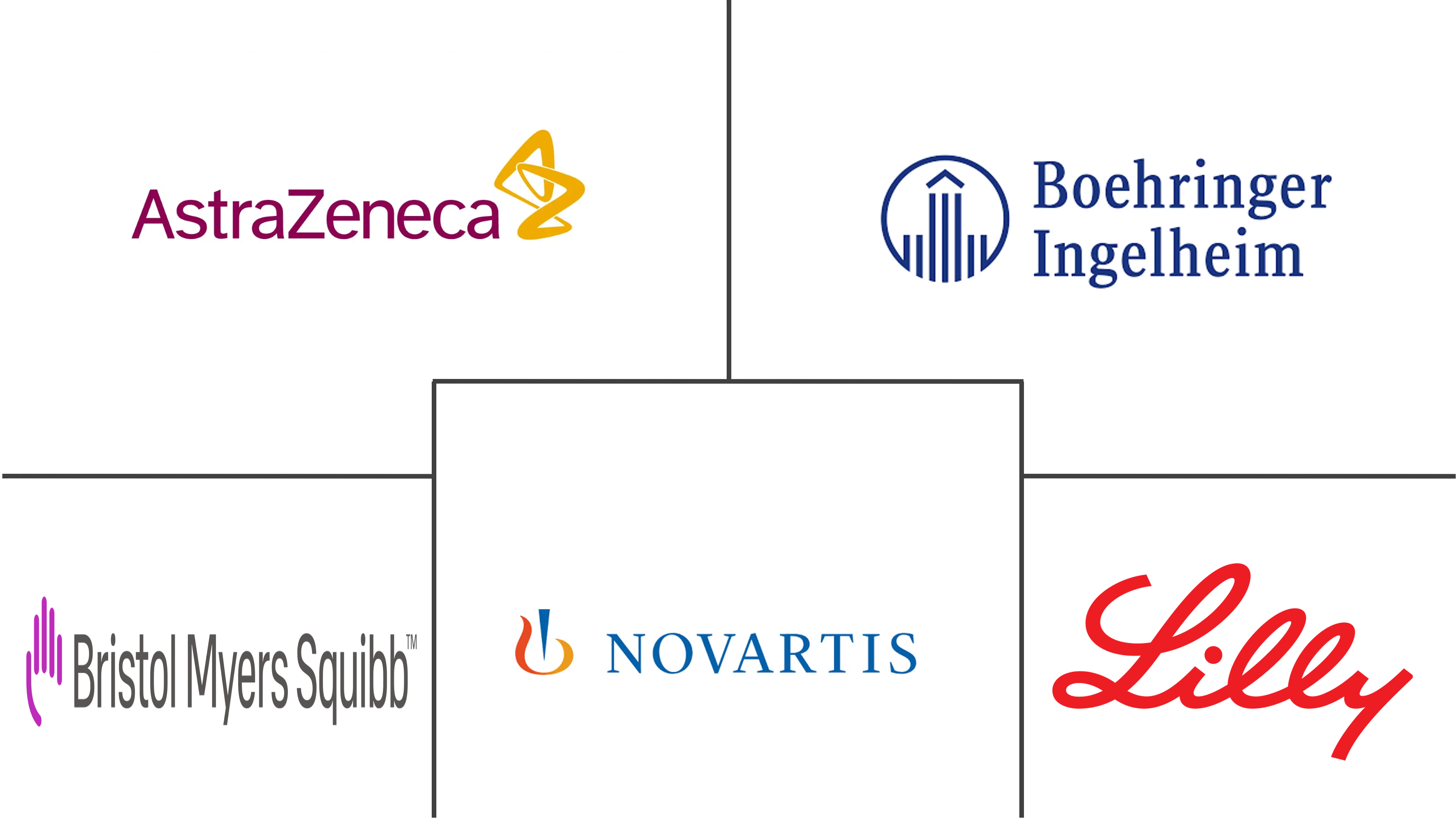Lung Cancer Therapeutics Market Size and Share
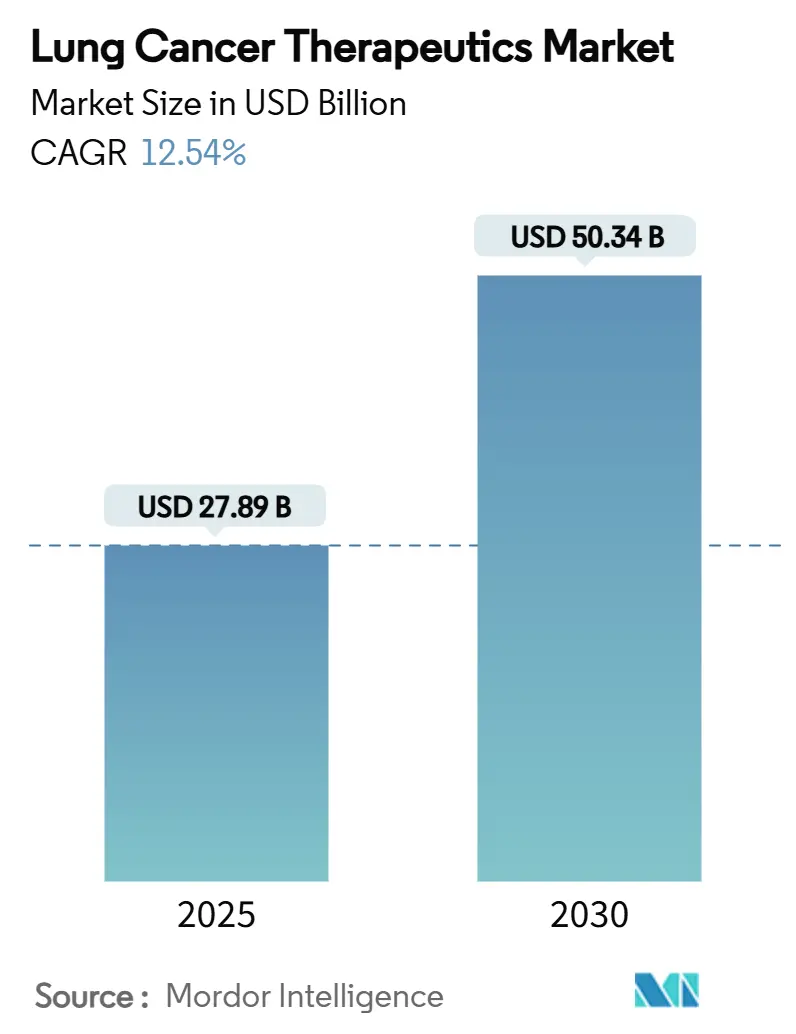
Lung Cancer Therapeutics Market Analysis by Mordor Intelligence
The lung cancer therapeutics market size stood at USD 27.89 billion in 2025 and is forecast to reach USD 50.34 billion by 2030, translating into a 12.54% CAGR. Rapid gains stem from immuno-oncology breakthroughs, bispecific antibodies, and wider global reimbursement adoption that collectively lift treatment volumes. Regulatory agencies expedited 11 new non-small cell approvals after 2024, underscoring an innovation cycle that compresses development timelines and intensifies competition. Precision biomarker testing has moved from specialist to mainstream practice, enabling mutation-matched drug selection and pushing response rates higher for previously hard-to-treat patients. Wider insurance coverage across Asia-Pacific and Latin America improves affordability, while price pressure in mature markets continues to nudge manufacturers toward value-based agreements. Strategic consolidation around combination platforms is accelerating as companies seek to defend positions before major patent cliffs arrive.
Key Report Takeaways
- By disease type, non-small cell lung cancer led with 77.23% revenue share in 2024; small-cell lung cancer is advancing at a 13.21% CAGR through 2030.
- By treatment modality, chemotherapy held 43.21% share of the lung cancer therapeutics market in 2024, while immunotherapy is projected to expand at 13.24% CAGR to 2030.
- By drug class, small-molecule agents accounted for 64.49% share in 2024, whereas biologics and biosimilars are rising at a 13.33% CAGR over the same horizon.
- By distribution channel, hospital pharmacies captured 69.98% share in 2024; retail pharmacies show the fastest trajectory at 13.23% CAGR through 2030.
- By line of therapy, first-line regimens commanded 55.36% share in 2024; third-line and later therapies record the highest projected CAGR at 13.39% to 2030.
- By geography, North America contributed 39.19% of 2024 revenue, yet Asia-Pacific is on track for a 13.56% CAGR to the end of the decade.
Global Lung Cancer Therapeutics Market Trends and Insights
Drivers Impact Analysis
| Driver | (~) % Impact on CAGR Forecast | Geographic Relevance | Impact Timeline |
|---|---|---|---|
| Increasing prevalence of lung cancer | +3.1% | Global, strongest in Asia-Pacific and emerging economies | Long term (≥ 4 years) |
| Rising pollution and smoking rates | +1.9% | Asia-Pacific core, spill-over to Middle East and urban centers worldwide | Medium term (2-4 years) |
| Rapid adoption of immuno-oncology therapies | +3.8% | North America and Europe lead, swift Asia-Pacific uptake | Short term (≤ 2 years) |
| Expanding healthcare reimbursement coverage | +2.5% | Global, highest acceleration in Asia-Pacific and Latin America | Medium term (2-4 years) |
| Precision-medicine biomarker testing uptake | +2.3% | North America and Europe mature, emerging Asia-Pacific markets | Short term (≤ 2 years) |
| Emerging cell and RNA-based therapy pipeline | +2.8% | North America and Europe early adoption, selective Asia-Pacific entry | Long term (≥ 4 years) |
| Source: Mordor Intelligence | |||
Rapid Adoption of Immuno-Oncology & Targeted Therapies
Checkpoint inhibitors combined with novel targets lift survival beyond legacy chemotherapy. Bispecific T-cell engagers such as tarlatamab post 40% objective responses in heavily pre-treated small-cell cases, while antibody-drug conjugates like datopotamab deruxtecan reach 45% responses in EGFR-mutated non-small-cell disease [1]U.S. Food and Drug Administration, "FDA grants accelerated approval to datopotamab deruxtecan-dlnk for EGFR-mutated non-small cell lung cancer," fda.gov. Thirteen lung cancer indications cleared the FDA’s accelerated pathway during 2024 alone, compressing launch cycles and intensifying rivalry [2]U.S. Food and Drug Administration, "Oncology Regulatory Review 2023," fda.gov. Combination regimens dominate pipelines as developers marry immune activation with mutation-specific blockade to blunt escape mechanisms. Biomarker-driven selection now guides most first-line decisions, enabling higher response depths and longer progression-free intervals. As new modalities gain first-line status, chemotherapy shifts toward a backbone role within multi-agent protocols rather than standalone therapy.
Precision-Medicine Biomarker Testing Uptake
Comprehensive molecular profiling is replacing histology-based selection. Next-generation sequencing panels, supported by FDA-cleared diagnostics such as the Oncomine Dx Express Test, are becoming standard for community oncologists [3]U.S. Food and Drug Administration," FDA grants accelerated approval to sunvozertinib for metastatic non-small cell lung cancer with EGFR exon 20 insertion mutations," fda.gov. Actionable alterations cover EGFR, ALK, ROS1, KRAS, HER2, MET, and BRAF, now informing choices for more than 60% of non-small-cell cases. Liquid biopsy expands real-time resistance monitoring, allowing therapy switches before clinical progression. Declining sequencing costs, along with payer reimbursement, embed biomarker testing into routine care across higher-income Asia-Pacific markets. Wider panels create additional commercial niches for targeted agents, reinforcing a virtuous cycle of test adoption and drug development.
Emerging Cell & RNA-Based Therapy Pipeline
Cellular immunotherapies and RNA constructs extend options beyond small molecules and antibodies. DLL3-targeted CAR-T cells report meaningful activity in small-cell disease, while CEACAM5-directed constructs enter non-small-cell trials. Individualized mRNA vaccines combined with checkpoint inhibition are advancing toward Phase III, capitalizing on patient-specific neoantigen signatures. TCR-T therapies widen the antigen universe by addressing intracellular targets. Radioligand candidates such as FXX489, which binds FAP, open a fresh class of precision payloads. Manufacturing scale-up and cost control remain hurdles, yet early efficacy signals energize investment and create merger targets for large manufacturers.
Expanding Healthcare Reimbursement Coverage
Governments and insurers broaden access as survival gains justify budget allocation. China’s National Healthcare Security Administration has listed multiple new lung agents, sharply lowering patient co-pays. The United States extended Medicare coverage to additional biomarker tests and breakthrough treatments, while Latin American payers negotiate risk-sharing contracts that tie payment to real-world outcomes. Value-based arrangements become common as dual and triple regimens prompt affordability debates. International reference pricing pressures high-income markets, yet also levels global prices, supporting adoption in lower-income countries. Real-world evidence collected through registries underpins these agreements and shapes formulary status.
Restraints Impact Analysis
| Restraint | (~) % Impact on CAGR Forecast | Geographic Relevance | Impact Timeline |
|---|---|---|---|
| High therapy costs and pricing pressures | -1.9% | Global, pronounced in emerging markets and uninsured populations | Short term (≤ 2 years) |
| Severe immune-related adverse events | -1.5% | Global, higher in elderly cohorts and multi-agent regimens | Medium term (2-4 years) |
| Looming patent cliffs for blockbuster drugs | -2.3% | North America and Europe primary, ripple effects in Asia-Pacific | Short term (≤ 2 years) |
| Limited biopsy access in low-resource areas | -1.0% | Emerging markets and rural settings worldwide | Long term (≥ 4 years) |
| Source: Mordor Intelligence | |||
High Therapy Costs & Pricing Pressures
Annual courses often exceed USD 200,000, straining payers and patients. Durvalumab’s acquisition price slowed global uptake despite survival benefit, with cost-effectiveness analyses finding unfavorable ratios in resource-constrained regions. Biosimilar pipelines for pembrolizumab and nivolumab are expected to erode pricing power, forcing originators into value-based deals. Combination regimens compound cost, and multi-year therapy durations magnify budget impact. Reference pricing frameworks in Europe and Latin America intensify discount expectations. Manufacturers respond by offering outcome guarantees and tiered pricing, yet access gaps persist in low-income countries.
Looming Patent Cliffs for Blockbuster Drugs
Keytruda’s core patents expire in 2028, exposing over USD 20 billion annual sales to biosimilar erosion. Bristol Myers Squibb and Roche confront similar timelines across their checkpoint portfolios. Generic entrants line up dossiers as regulatory pathways for complex biologics mature. Innovators prioritize lifecycle extensions, including novel combinations, subcutaneous formulations, and new tumor sites. M&A activity targets early-stage assets that can replenish revenue streams. Market volatility is expected as payers leverage competitive bids to slash prices, potentially expanding access but squeezing margins.
Segment Analysis
By Disease Type: NSCLC Dominance Faces SCLC Innovation
Non-small cell disease generated 77.23% of 2024 revenue within the lung cancer therapeutics market share, benefiting from broad biomarker-driven options and high incidence. The small-cell segment holds a smaller base yet is forecast to outpace at 13.21% CAGR through 2030, fueled by the first-in-class bispecific tarlatamab and checkpoint additions. The lung cancer therapeutics market size for small-cell therapy is therefore projected to climb swiftly from a low anchor point. Precision approaches in NSCLC, such as EGFR and KRAS inhibitors, keep that segment sizeable, but pipeline momentum is visibly shifting SCLC from neglect to opportunity.
Continued SCLC innovation narrows historic survival gaps. Tarlatamab reached 40% objective responses in heavily pre-treated cohorts, and durvalumab pushed median overall survival to 55.9 months in limited-stage settings. NSCLC pipelines add HER2 and MET inhibitors plus antibody-drug conjugates to re-intercept resistance, keeping volume leadership intact. Together, both segments illustrate a diversification that attracts specialized players while pushing incumbents to broaden portfolios.
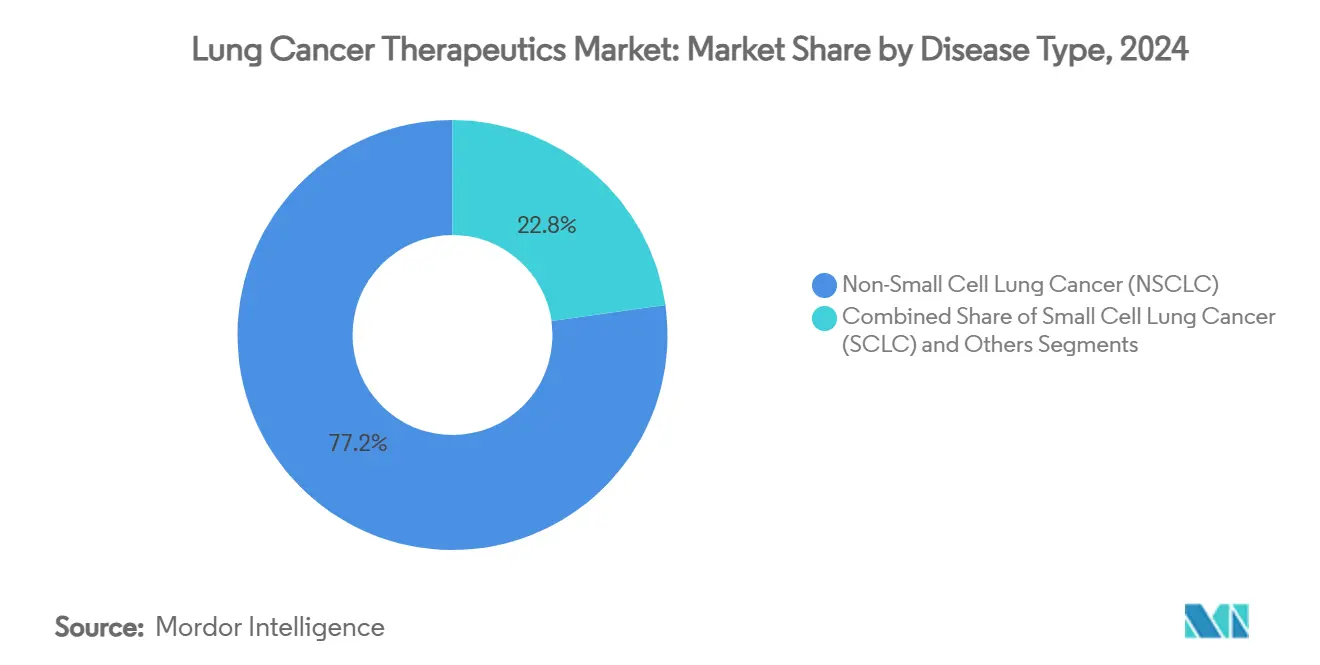
Note: Segment shares of all individual segments available upon report purchase
By Treatment Modality: Immunotherapy Disrupts Chemotherapy Hegemony
Chemotherapy still accounted for 43.21% of 2024 revenue, yet immunotherapy is projected to climb at 13.24% CAGR, eroding monotherapy chemo reliance. Checkpoint inhibitors moved into first-line PD-L1-positive care, and bispecifics headline second-line SCLC protocols. The lung cancer therapeutics market size allocated to immunotherapy is forecast to double over the decade. Targeted agents add steady mid-single-digit growth by focusing on well-defined biomarkers.
Combination regimens are rising. Durvalumab plus chemotherapy extended survival in limited-stage SCLC, while chemo-IO combos dominate non-small cell first-line practice. As pipelines fill with T-cell engagers and antibody-drug conjugates, immunotherapy’s reach broadens into biomarker-low populations, enlarging addressable demand while reshaping safety management norms.
By Drug Class: Biologics Challenge Small-Molecule Dominance
Small molecules retained 64.49% revenue in 2024, helped by oral dosing and cost-efficient manufacture. Biologics and biosimilars, however, are predicted to advance 13.33% per year, trimming the gap by 2030. The lung cancer therapeutics market size for biologics will grow sharply as monoclonal antibodies, bispecifics, and radioligand conjugates gain ground. Hybrid formats like antibody-drug conjugates mix biologic targeting with potent small-molecule payloads, illustrating convergence.
Patent cliffs heighten change. Pembrolizumab biosimilars threaten incumbent biologics’ price premium, while oral small-molecule brands chase ever-smaller niches to escape generic assault. As manufacturing technology for antibodies scales, cost barriers decline, tilting favor toward biologics for difficult targets with limited small-molecule tractability.
By Distribution Channel: Retail Expansion Challenges Hospital Dominance
Hospital pharmacies dominated distribution with 69.98% revenue in 2024 because infusion-based regimens demand specialized oversight. Retail outlets, including specialty chains, are forecast for a 13.23% CAGR due to oral targeted therapies and supportive drugs that patients can manage at home. The lung cancer therapeutics market share routed through retail remains smaller but is expanding steadily.
Growth reflects healthcare decentralization. Oral EGFR, ALK, and KRAS inhibitors shift dispensing to the community, lowering patient travel burden. Specialty pharmacy programs supply adherence monitoring and cold-chain logistics, matching hospital standards. Hospitals maintain a critical role for complex infusions and acute-care rescue, preserving their lead.
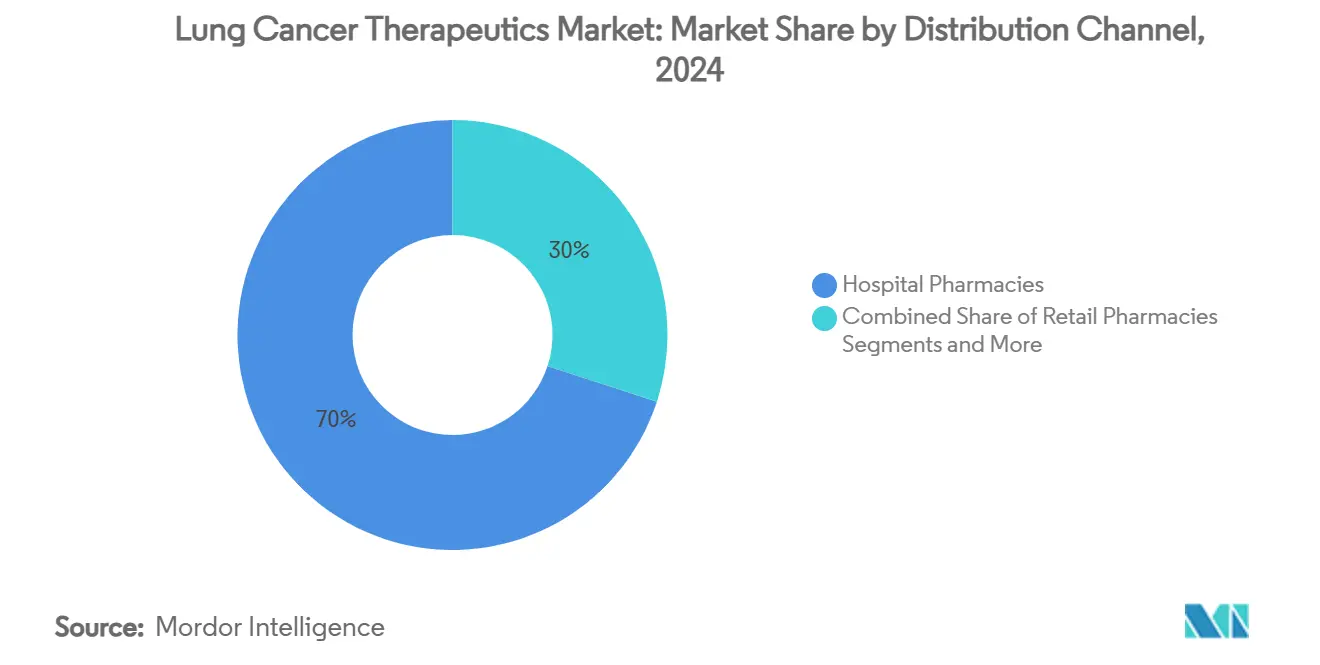
By Line of Therapy: Sequential Treatment Drives Later-Line Growth
First-line protocols delivered 55.36% of 2024 sales, yet third-line and beyond treatments are set for the fastest growth at 13.39% CAGR. The lung cancer therapeutics market size in later lines benefits from extended survival that enlarges eligible cohorts. Second-line growth is moderate, sustained by agents designed to overcome specific resistance mutations.
Recent approvals illustrate momentum. Tarlatamab improved overall survival in second-line SCLC versus chemo and is expected to migrate earlier as data mature. A richer therapy arsenal compels oncologists to strategize sequences that conserve options for eventual resistance, reinforcing continual demand across all lines.
Geography Analysis
North America generated 39.19% of global revenue in 2024. Advanced trial infrastructure enables rapid translation from study to practice. Insurance systems fund high-cost regimens, though price negotiations tighten as biosimilars loom. Academic centers accelerate guideline updates, keeping adoption curves steep. Canada and Mexico participate through cross-border trials, widening patient access.
Asia-Pacific is the chief growth engine at 13.56% CAGR. China’s reimbursement expansion and local innovation double-team to unlock suppressed demand. Japan’s accelerated programs shorten review to 6 months for priority therapies, while Australia leverages expedited pathways for unmet-need cancers. India and Southeast Asia scale diagnostic capacity, installing NGS panels in tertiary hospitals. Economic development and urban pollution jointly increase lung burden, sustaining volume growth.
Europe exhibits steady mid-single-digit gains. Centralized EMA approvals speed simultaneous market launches, but reimbursement decisions remain country specific. Health technology assessment bodies focus on value thresholds, nudging manufacturers toward managed-entry agreements. Eastern European markets catch up through EU cohesion funding for oncology infrastructure. Brexit triggered parallel pathways in the United Kingdom, yet mutual recognition maintains most supply routes.
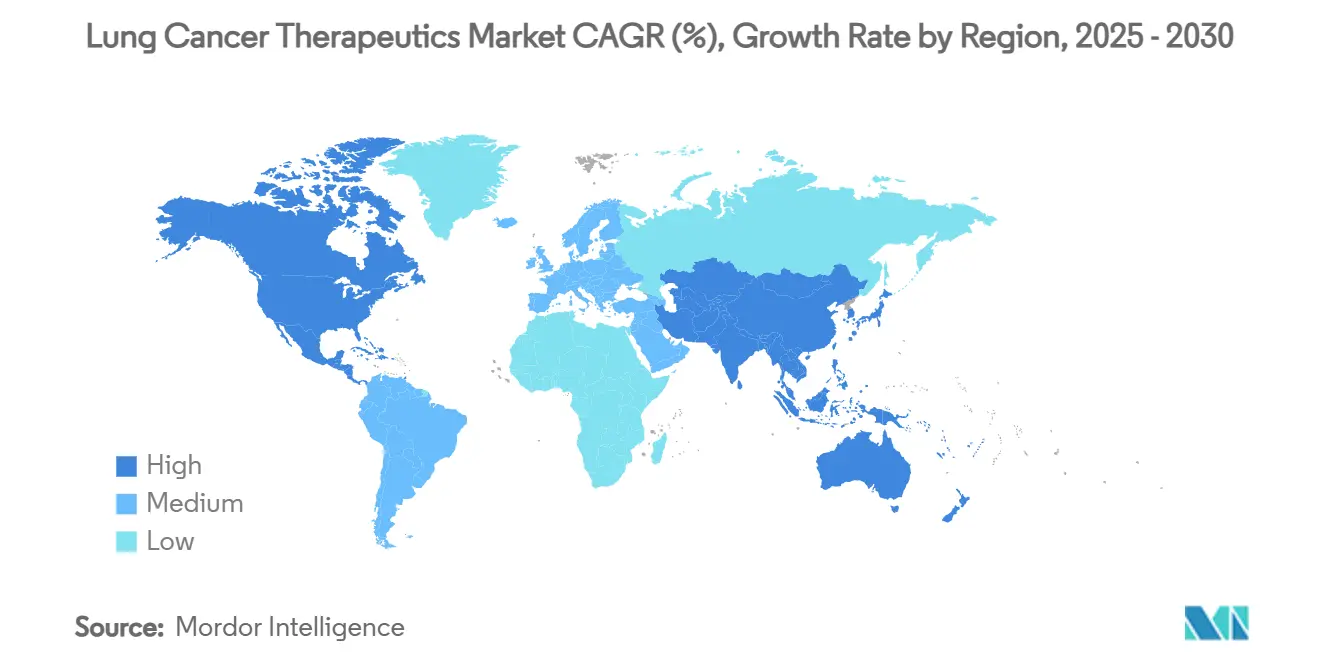
Competitive Landscape
Sixteen major firms share the market, producing moderate fragmentation. F. Hoffmann-La Roche, AstraZeneca, and Merck anchor checkpoint franchises, while Bristol Myers Squibb and Pfizer span multiple modalities. Patent expiries, notably Keytruda’s in 2028, invite biosimilar entries that threaten entrenched share. Developers respond by bundling assets: AstraZeneca couples durvalumab with antibody-drug conjugates, and Johnson & Johnson combines amivantamab with lazertinib to counter osimertinib resistance.
Emergent Asian biotechs such as BeiGene and Innovent gain global profiles through PD-1 antibodies priced 30–40% below Western peers, adding cost competition. Technology convergence shapes future positioning. AI-driven screening cuts hit-to-lead timelines, while in-house diagnostic units secure companion tests. Radioligand and cell therapy capabilities are acquisition priorities, illustrated by recent tie-ups between large pharma and nuclear-medicine specialists. The race favors platforms that supply combination flexibility, cost-disciplined manufacturing, and global supply chain reach.
Lung Cancer Therapeutics Industry Leaders
-
AstraZeneca
-
Boehringer Ingelheim
-
Bristol-Myers Squibb Company
-
Novartis AG
-
Eli Lilly and Company
- *Disclaimer: Major Players sorted in no particular order
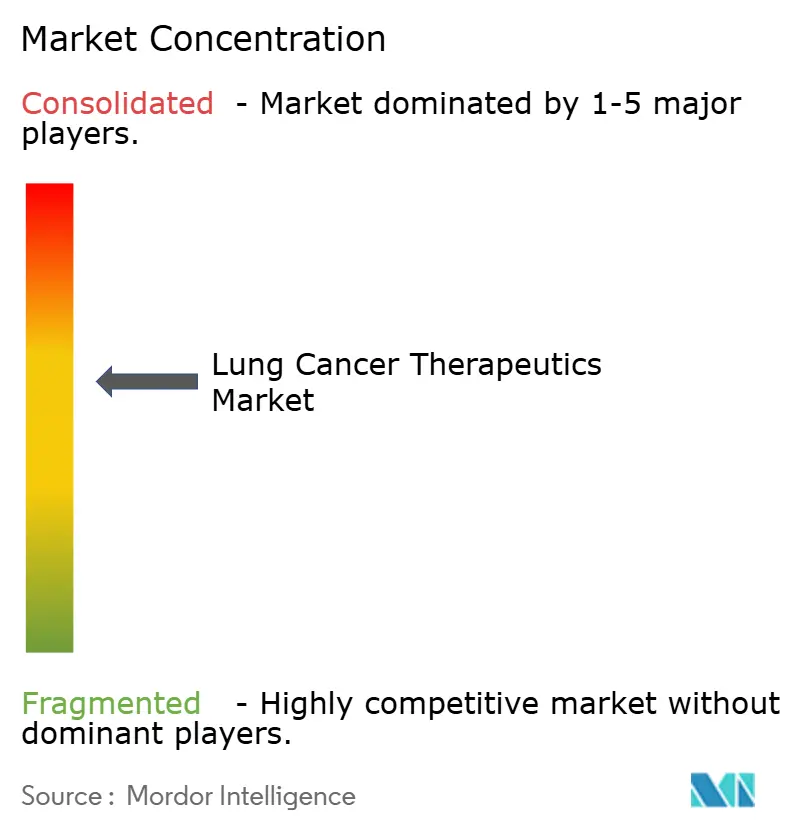
Recent Industry Developments
- July 2025: The FDA granted accelerated approval to sunvozertinib (Zegfrovy) for adults with locally advanced or metastatic EGFR exon 20 insertion NSCLC, demonstrating a 46% overall response and 11.1-month duration in WU-KONG1B.
- June 2025: Datopotamab deruxtecan-dlnk (Dato-DXd) received FDA accelerated approval for EGFR-mutated NSCLC after prior EGFR therapy and platinum chemotherapy, posting a 45% response and 6.5-month median duration.
- May 2025: Johnson & Johnson reported that Rybrevant plus lazertinib outperformed Tagrisso monotherapy in EGFR-mutated disease, extending progression-free survival in a Phase III readout.
- April 2025: The FDA cleared durvalumab for limited-stage small-cell lung cancer, citing a 55.9-month median overall survival versus 33.4 months for placebo.
Global Lung Cancer Therapeutics Market Report Scope
As per the scope of the report, lung cancer or lung carcinoma is a disease characterized by uncontrolled cell growth in the lungs. Common symptoms include cough, chest pain, weight loss, and shortness of breath. Lung cancer therapeutic drugs and surgery are therapies aimed at diminishing, stunting, destroying, or killing the cancerous growth and cells in the lungs. The Lung Cancer Therapeutics Market is Segmented by Disease Type (Non-small Cell Lung Cancer and Small Cell Lung Cancer), Treatment (Chemotherapy, Radiation Therapy, Immunotherapy, Targeted Therapy, and Other Treatments), and Geography (North America, Europe, Asia-Pacific, Middle East and Africa, and South America). The Market report also covers the estimated market sizes and trends of 17 countries across major regions globally. The report offers the value (in USD million) for all the above segments.
| Non-Small Cell Lung Cancer (NSCLC) |
| Small Cell Lung Cancer (SCLC) |
| Others |
| Chemotherapy |
| Immunotherapy |
| Targeted Therapy |
| Small-Molecule Drugs |
| Biologics and Biosimilars |
| Hospital Pharmacies |
| Retail Pharmacies |
| Online Pharmacies |
| First-Line |
| Second-Line |
| Third-Line and Beyond |
| North America | United States |
| Canada | |
| Mexico | |
| Europe | Germany |
| United Kingdom | |
| France | |
| Italy | |
| Spain | |
| Rest of Europe | |
| Asia-Pacific | China |
| Japan | |
| India | |
| Australia | |
| South Korea | |
| Rest of Asia-Pacific | |
| Middle East and Africa | GCC |
| South Africa | |
| Rest of Middle East and Africa | |
| South America | Brazil |
| Argentina | |
| Rest of South America |
| By Disease Type | Non-Small Cell Lung Cancer (NSCLC) | |
| Small Cell Lung Cancer (SCLC) | ||
| Others | ||
| By Treatment Modality | Chemotherapy | |
| Immunotherapy | ||
| Targeted Therapy | ||
| By Drug Class | Small-Molecule Drugs | |
| Biologics and Biosimilars | ||
| By Distribution Channel | Hospital Pharmacies | |
| Retail Pharmacies | ||
| Online Pharmacies | ||
| By Line of Therapy | First-Line | |
| Second-Line | ||
| Third-Line and Beyond | ||
| By Geography | North America | United States |
| Canada | ||
| Mexico | ||
| Europe | Germany | |
| United Kingdom | ||
| France | ||
| Italy | ||
| Spain | ||
| Rest of Europe | ||
| Asia-Pacific | China | |
| Japan | ||
| India | ||
| Australia | ||
| South Korea | ||
| Rest of Asia-Pacific | ||
| Middle East and Africa | GCC | |
| South Africa | ||
| Rest of Middle East and Africa | ||
| South America | Brazil | |
| Argentina | ||
| Rest of South America | ||
Key Questions Answered in the Report
What is the projected value of the lung cancer therapeutics market by 2030?
The market is forecast to reach USD 50.34 billion by 2030, supported by a 12.54% CAGR.
Which disease segment is expanding fastest within lung cancer treatment?
Small-cell lung cancer therapies are expected to grow 13.21% annually through 2030, outpacing non-small-cell treatments.
How will Keytrudas 2028 patent expiry influence competition?
Biosimilar entries are set to erode premium pricing and open a USD 20 billion revenue gap, prompting originators to launch next-generation drugs.
Why is Asia-Pacific the most attractive growth region for lung cancer treatments?
Expanding reimbursement, large patient populations, and streamlined regulatory pathways drive a 13.56% CAGR in the region.
Which drug class will gain the most share against small molecules over the decade?
Biologics, including monoclonal antibodies and bispecifics, are projected to climb at 13.33% CAGR, narrowing the gap with small molecules.
What role do retail pharmacies play in future lung cancer drug distribution?
Oral targeted therapies and specialty support programs are moving more dispensing to retail outlets, which are set for a 13.23% CAGR.
